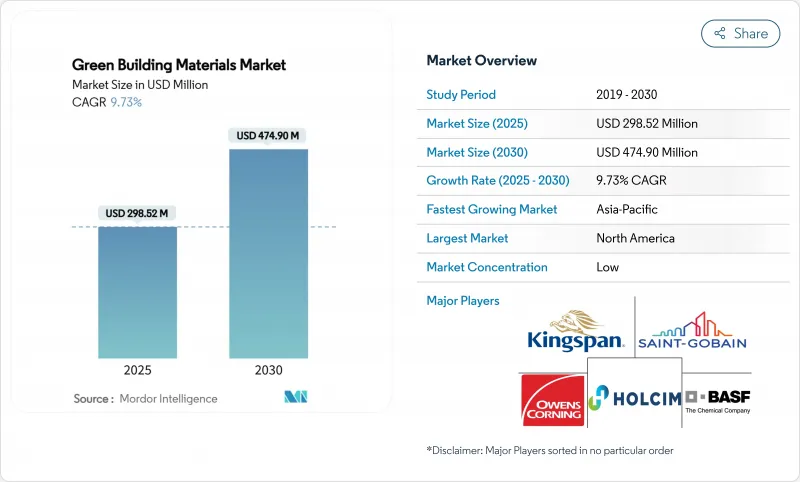
|
市場調査レポート
商品コード
1851274
グリーン建材:市場シェア分析、産業動向、統計、成長予測(2025年~2030年)Green Building Materials - Market Share Analysis, Industry Trends & Statistics, Growth Forecasts (2025 - 2030) |
||||||
カスタマイズ可能
適宜更新あり
|
|||||||
| グリーン建材:市場シェア分析、産業動向、統計、成長予測(2025年~2030年) |
|
出版日: 2025年07月18日
発行: Mordor Intelligence
ページ情報: 英文 120 Pages
納期: 2~3営業日
|
概要
グリーン建材市場規模は2025年に2億9,852万米ドルと推定され、2030年には4億7,490万米ドルに達すると予測され、予測期間(2025-2030年)のCAGRは9.73%です。

この見通しは、ゼロ・エミッション建設に対する持続的な政策圧力、企業のネット・ゼロコミットメントの高まり、低炭素材料技術の急速な拡大などを反映しています。欧州連合(EU)、米国、その他の主要経済国間の規制の調整により、歴史的な分断が解消されつつあり、世界のメーカーが規模の効率性を獲得し、製品イノベーションを加速できるようになっています。需要はさらに、従来製品との価格差を縮める財政的インセンティブによって支えられており、デジタル材料追跡ツールは、使用済み製品の価値の流れを収益化し始めています。これらの要因が相まって、グリーン建材市場はこれまでに経験したことのない急速な普及サイクルを迎えています。
世界のグリーン建材市場の動向と洞察
義務化されるエネルギー効率基準の厳格化
世界の建築基準法は、自主的なガイドラインから拘束力のある性能基準へと移行しつつあります。欧州では、改正建築物エネルギー性能指令により、2030年までにすべての新築建築物が現場での化石燃料排出量ゼロを達成することが義務付けられ、既存の住宅は同年までに少なくともEランクにアップグレードしなければならないです。米国は、2024年国際エネルギー保全規約(International Energy Conservation Code)を制定し、これに追随しています。規範の厳格化は、高性能断熱材、低炭素コンクリート、先進ファサードへの需要を押し上げ、デジタル・コンプライアンス・プラットフォームを通じて製品の持続可能性を検証できるサプライヤーに報います。施行が強化されることで、従来の材料のコンプライアンス・コストがさらに上昇し、認証された代替材料に耐久性のある競争上の優位性が生まれます。
政府インセンティブと認証制度
税額控除、グリーンボンド、優遇融資は、プロジェクトの経済性を一変させています。米国のインフレ削減法第45L条は、対象となる住宅1戸につき最高5,000米ドルを提供し、179D控除は現在、より大規模な商業用改修を対象としています。カナダは、クリーン・エネルギー・インフラに100億カナダドルを計上し、認証された材料に資金を誘導しています。LEED、WELL、ENERGY STARなどのプログラムが現在割引融資とリンクしているため、開発者は先進製品に関連する15~25%の価格プレミアムを相殺することができます。このようなインセンティブは、コストに敏感なセグメントにおける採用を加速させ、最新の認証ポートフォリオを維持するメーカーに信頼できる収益源を生み出します。
認証材料の高い初期費用
認証製品は、試験、特殊加工、少量生産により、通常15~25%の価格プレミアムがついています。このプレミアムは、住宅建設において最も顕著であり、購入者は最初のコストに重点を置き、ライフサイクルの節約を見落とす可能性があります。カーボン・マイナス・コンクリートやバイオベース断熱材などの新しい製品には、研究開発費もかかります。数量が増加し、カーボンプライシングによってコスト差が縮まるにつれて減少するもの、特に強力なインセンティブプログラムのない発展途上地域では、先行費用の増加が当面の導入障壁となります。
セグメント分析
低炭素コンクリート・セメントは、2024年のグリーン建材市場シェアの24.45%を占め、従来のセメントに関連する世界の温室効果ガス排出量の8%を削減することが業界の緊急課題であることを明確にしました。強度を維持しながらCO2を45%隔離する鉱物炭化プロセスなどの画期的な技術は、パイロットから限定的な商業規模に移行しています。ハイデルベルグ・マテリアルズのレングフルト・プロジェクトは、年間7万トンのCO2を回収する予定であり、主流となる可能性を示しています。リサイクル金属は、構造用鋼のスクラップ含有率が日常的に93%であり、使用済み時の回収率が98%であることから、信頼できる需要を維持しています。集成材に代表されるエンジニアリングウッド製品は、より迅速な組み立て、より軽量な基礎、現場での炭素貯蔵を武器に、デベロッパーによって拡大しつつあります。ミネラルウール断熱材は、新しい不燃性製品ラインのおかげで依然として定番であり、セルロースとバイオフォーム断熱材は、再生可能な原材料と高い断熱性能に支えられて、CAGR 10.59%で進展しています。リサイクルプラスチック複合材料は、ライフサイクル評価によって微小プラスチックの脱落が懸念されるため、より選択的に成長しているが、木質ポリマーボードは引き続きエクステリアデッキやファサードのニッチに浸透しています。
成長の見込みは素材によって異なります。低炭素バインダーは、機内炭素吸収助成金の恩恵を受けており、炭素価格制度が拡大すれば成長が加速すると思われます。大量木材市場は、認証林の生産能力の拡大と建築基準法の高さ制限の改正にかかっています。セルロースの成長軌道は、十分な消費者使用後の紙資源の確保と酵素処理プラントの拡大にかかっています。全体として、素材の革新は競争上の差別化を強化し、既存企業は循環型経済機能、検証済みのカーボンフットプリント、デジタル・パスポートをすべての製品ラインに組み込む必要に迫られます。
地域分析
北米は2024年のグリーン建材市場規模の40.80%を占めたが、これは長年にわたるENERGY STARとLEEDプログラム、および州レベルのゼロ・エネルギー対応建物義務化を反映しています。インフレ削減法に基づく連邦税額控除は、国の整合性を強化し、カリフォルニア州の2025年基準サイクルは、具体化炭素制限をさらに強化すると予想されます。カナダのグリーン・ホームズ・イニシアチブは、低利融資を改修アップグレードに振り向け、セルロースとミネラルウールの断熱材需要を刺激しています。
欧州では、建物のエネルギー性能に関する指令(Energy Performance of Buildings Directive)と、今後予定されている炭素国境調整メカニズム(Carbon Border Adjustment Mechanism)により、高炭素の輸入コストを引き上げ、国内の低炭素生産にインセンティブを与えることで、高い導入ベースラインを維持しています。スカンジナビア諸国はすでに、すべての大規模建築物に対して全ライフサイクルでの炭素評価を義務付けており、デジタルパスポートと大量木材の需要を加速させています。ドイツとフランスは公共部門による低炭素コンクリートの調達を主導し、英国は都市部の解体から再利用可能な資材を回収する循環型建設ハブを試験的に設置しています。
アジア太平洋地域は、急速な都市化と進化するグリーンビルディング規範が合致し、2030年までCAGR 11.36%で拡大すると予測されます。中国では、2025年までにすべての新規プロジェクトが少なくともベーシックグレードのグリーン認証を取得することが義務付けられています。インドの省エネルギー建築基準法(Energy Conservation Building Code)とインドネシアのグリーンビルディング協議会(Green Building Council)の評価制度が、早期の導入を後押ししているが、自治体による施行が断片的であるため、短期的な普及には限界があります。すでに成熟しているオーストラリアとシンガポールは、地域全体に専門知識を輸出し、サプライチェーンの現地化と地域認証基準を強化しています。
南米と中東・アフリカはまだ始まったばかりだが、インフラ投資が拡大する中、魅力的な地域です。ブラジルのProcel Edificaラベリング制度とアラブ首長国連邦のEstidama Pearl格付け制度は、気候特有の性能ニーズを満たすため、材料供給業者に生産の現地化を促しています。資金調達は依然として大きなハードルだが、多国間銀行がグリーンボンドをこうした市場に供給する動きが活発化しており、次の計画サイクルでは加速度的に導入が進むことが予想されます。
その他の特典:
- エクセル形式の市場予測(ME)シート
- 3ヶ月のアナリストサポート
よくあるご質問
目次
第1章 イントロダクション
- 調査の前提条件と市場の定義
- 調査範囲
第2章 調査手法
第3章 エグゼクティブサマリー
第4章 市場情勢
- 市場概要
- 市場促進要因
- エネルギー効率規制の強化
- 政府奨励金と認証制度
- 企業のネット・ゼロ、組込み炭素調達
- 老朽化したビルストックにレトロフィットの波
- 使用済み価値を収益化するデジタル素材パスポート
- 市場抑制要因
- 認証原料の高い初期コスト
- 地域間の認証と性能の複雑性
- 2027年以降のバイオベース原料の供給不足
- バリューチェーン分析
- ポーターのファイブフォース
- 供給企業の交渉力
- 買い手の交渉力
- 新規参入業者の脅威
- 代替品の脅威
- 競合の程度
第5章 市場規模と成長予測
- 素材タイプ別
- 低炭素コンクリートとセメント
- リサイクル金属
- エンジニアード/再生木材
- ミネラルウール断熱材
- セルロースとバイオフォーム断熱材
- 再生プラスチック複合材料
- 用途別
- フレーム
- 絶縁
- 屋根
- 外装サイディング
- 内装仕上げ
- その他の用途
- エンドユーザー業界別
- 住宅用
- 商業用
- 産業用および施設用
- インフラストラクチャー
- 地域別
- 北米
- 米国
- カナダ
- メキシコ
- 欧州
- ドイツ
- 英国
- フランス
- イタリア
- その他欧州地域
- アジア太平洋地域
- 中国
- インド
- 日本
- 韓国
- その他アジア太平洋地域
- 南米
- ブラジル
- アルゼンチン
- その他南米
- 中東・アフリカ
- サウジアラビア
- 南アフリカ
- その他の中東・アフリカ
- 北米
第6章 競合情勢
- 市場集中度
- 戦略的動向
- 市場シェア(%)/ランキング分析
- 企業プロファイル
- BASF
- Binderholz GmbH
- Cemex S.A.B. de C.V.
- Coromandel International Ltd.
- DuPont
- Heidelberg Materials
- Holcim Ltd
- Interface Inc.
- Kingspan Group
- Owens Corning
- PPG Industries Inc
- Rockwool A/S
- Saint-Gobain
- Sika AG
- SmartLam
- Steico SE
- Weyerhaeuser Company

